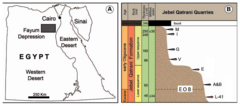| Jebel Qatrani Formation | |
|---|---|
| Stratigraphic range: Eocene-Oligocene ~ | |
 | |
| Type | Formation |
| Sub-units | Lower Sequence (Lower Fossil Wood Zone)
Barite Sandstone Upper Sequence (Upper Fossil Wood Zone) |
| Underlies | Widan el Faras Basalt |
| Overlies | Qasr el Sagha Formation |
| Area | Fayum Depression |
| Thickness | 340 m |
| Lithology | |
| Primary | sandstone, mudstone |
| Location | |
| Region | Faiyum Governorate |
| Country | |
The Jebel Qatrani Formation (also Gebel Qatrani, Gabal Qatrani or Djebel Qatrani) is a geologic formation located in the Faiyum Governorate of central Egypt. It is exposed between the Jebel Qatrani escarpment and the Qasr el Sagha escarpment, north of Birket Qarun lake near Faiyum. The formation conformably overlies the Qasr el Sagha Formation and is topped by the Widan el Faras Basalt. The age of the formation has been subject to debate, but the most recent research indicates that it covers both the latest parts of the Eocene and the Early Oligocene, spanning over the boundary between these two time periods.
The geology and fauna of this formation gives a good idea of the environment and animals present during this time period. Research suggests that the Jebel Qatrani Formation featured a mix of subtropical to tropical forest, lowland swamps and marshes, ponds and rivers that would empty northward into the Tethys Sea. This is supported by the presence of water-dependent fauna including podocnemidid turtles, crocodilians, sea cows, various fish, jacanas, early flamingo-relatives, ospreys, herons and shoebills.
Besides these, the fossil record of the Jebel Qatrani Formation is especially well known for its value to understanding the early evolution of many modern mammal groups. Primates are represented by over a dozen genera, several forms of early elephants have been recovered from the sediments including the terrestrial Phiomia and the semi-aquatic Moeritherium. The fossil rodents of the formation meanwhile are thought to be an important link between the African phiomorphs (dassies, old world porcupines, mole rats and cane rats) and the caviomorphs of South America (capybaras, chinchillas and new world porcupines). Besides these early members of groups that would later rise to prominence, the formation was also home to a variety of unique groups no longer found today or only found in a greatly diminished diversity. This includes the enigmatic, possibly carnivorous ptolemaiids, large hyaenodonts, a vast number of highly diverse hyracoids including species the size of rhinos, anthracotheres and the bizarre embrithopod Arsinoitherium.